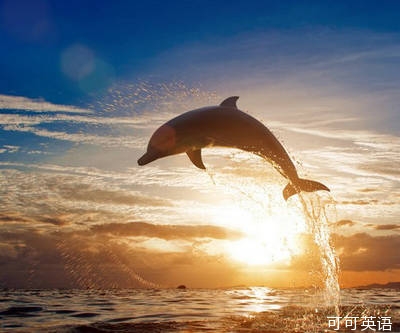Many people know that marine mammals, like whales, porpoises and dolphins, breathe air, like wedo.
大多数人都知道些海洋哺乳动物,比如鲸鱼,鼠海豚和海豚。它们和我们一样都要呼吸空气。
But, many people don't know that marine mammals have developed some interesting sleepinghabits in order to accommodate their regular trips up to the surface for air.
但是大多数人都不知道这些哺乳动物已经养成了一些有趣的睡眠习惯,以配合来回水面呼吸空气。
Today, A Moment ofScience looks at what its like to sleep with the fishes.
今天,科学一刻将探究一下,这些哺乳动物是如何像鱼类一样睡觉的。
 Unlike our own breathing, which does not require conscious effort, marine mammals mustconsciously go to the surface of the water to breathe through a blowhole on top of their heads.
Unlike our own breathing, which does not require conscious effort, marine mammals mustconsciously go to the surface of the water to breathe through a blowhole on top of their heads.
与人类“无意识”呼吸不同,这些动物必须到水面,通过头顶的气孔,进行“有意识”的呼吸。
Because of this, marine mammals don't sleep for a solid 8 hours a night, the way we do.
因此,它们不像我们,每晚能够稳定的睡上八小时。
Some marine mammals sleep while swimming.
有些海洋哺乳动物边睡觉边游动。
Whales nap for brief periods while swimmingalongside an alert friend who guides them.
对于鲸鱼,只要有同伴放风,并引导着,他们就会边游边打会个盹。
In fact, young whales must sleep alongside their motherbecause the mother's slipstream actually pulls the calf along: it will sink if the mother stops.
实际上,幼鲸必须在母鲸身边睡觉,因为母鲸游动时产生的水流可以推动幼崽向前:如果母鲸停止游动,幼崽就会沉下去。
Other marine mammals, like dolphins, sleep while floating on the surface of the water or take shortcatnaps while floating below the surface.
而其它海洋哺乳动物,像海豚,睡觉的时候是浮在水面上,打盹的时候就浮在水面下。
Researchers claim that while marine mammals sleep theirbrain is always partially alert.
研究表明,海洋哺乳动物睡觉时,他们部分大脑依然保持警觉。
Aside from these brief naps, dolphins are active most of the night.
海豚在晚上,除了打盹,其余时间都处于活跃状态。
Of course, marine mammals are equipped to handle underwater sleeping.
当然,也有些海洋哺乳动物具备水下睡觉的能力。
They haveproportionately larger lungs, exchange air more fully at each breath, and carry more oxygen intheir blood than we do, so they can hold their breath long enough to sleep with the fishes.
相应地,他们的肺都很大,每次呼吸都能换进更多的空气。他们的血液中的含氧量就比我们的高,这样他们就能长时间屏息,像鱼类一样睡觉。
 Unlike our own breathing, which does not require conscious effort, marine mammals mustconsciously go to the surface of the water to breathe through a blowhole on top of their heads.
Unlike our own breathing, which does not require conscious effort, marine mammals mustconsciously go to the surface of the water to breathe through a blowhole on top of their heads.











